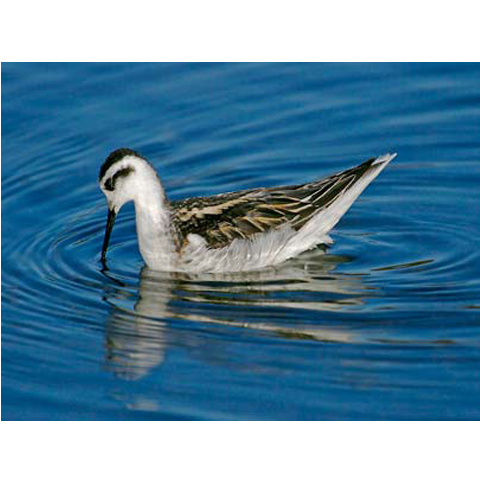Science news

15-May-2008
Scientists solve bird beak mystery
Birds' beaks come in all different shapes and sizes depending on the food they eat. The hummingbird's beak is long and thin, which lets it reach the nectar inside the deep flowers it feeds on. The short, strong finch beak is ideal for cracking open seeds. The eagle has a hooked beak to tear the flesh of its prey.
Birds' beaks are almost perfectly matched to the way each different kind of bird feeds - as Charles Darwin first pointed out nearly 150 years ago.
Now a team of mathematicians and engineers at the Massachusetts Institute of Technology has explained exactly how shorebirds use their long, thin beaks to defy gravity and get food into their mouths. The MIT team reports on its research in the May 16 issue of Science.
In a spin
They have been studying the phalarope, a shorebird that is commonly found in western North America. Wildlife biologists have long known about the unusual way phalaropes feed. They spin in circles on the water, creating a vortex that sweeps small crustaceans up to the surface, like tea-leaves in a swirling teacup.
The birds then peck at the surface, picking up tiny droplets of water with their prey trapped inside. Since their beaks are pointed down, the drops must be moved up the long beak against the pull of gravity.
Unknown force
A force between the beak and the droplets of water pushes the food from the tip of its long beak to its mouth. But until now scientists did not really understand how this force worked.
They knew it must be coming from the drop's surface tension. This is the main force in small water-worlds, such as insects on a pond. But they didn't know exactly how this could push the droplet up the bird's beak.
A key observation was that the birds open and close their beaks in a tweezering motion to move the drop. To learn more about how this helped, Bush teamed up with Manu Prakash, a graduate student in MIT's Center for Bits and Atoms, and with David Quéré of the Ecole Polytechnique in Paris. He was a visiting professor in MIT's mathematics department at the time of the study.
Bird-beak model
Together the scientists built a mechanical model of the phalarope beak. They then studied this to see in slow motion just what happens.
They found that the drop goes up the beak because of something called contact angle hysteresis. Usually this makes liquid drops stick to solids. Raindrops for instance stick to window panes because of contact angle hysteresis.
But the scientists found that the shape of the phalarope's beak, combined with contact angle hysteresis, is what moves the drop upward.
“This may be the first known example where droplet motion is enabled rather than resisted by contact angle hysteresis,” Bush says.
Scissors and ratchets
As the beak scissors open and shut, each movement propels the water droplet one step closer to the bird's mouth. When the beak closes, the drop's leading edge moves toward the mouth, while the trailing edge stays put. When the beak opens, the leading edge stays in place while the trailing edge moves toward the mouth.
It's a series of steps, like a ratchet. So the authors have given it a name - the “capillary ratchet”.
The scientists found that how well the whole thing works depends on the shape of the beak. So does how fast the drop moves. The fastest it can move is about 1 metre per second. Long, narrow beaks work best. The opening and closing angles of the beak are also important.
“Varying these angles by a few degrees can change the drop speed by a factor of 10,” Quere says.
Getting really wet
The working of the capillary ratchet also depends strongly on a property of the beak called "wettability". This is a measure of how well a liquid spreads out to wet a surface, rather than forming droplets. Oil for instance is much more “wetting” than water. So if the beak has oil on it from a spill, the capillary ratchet won't work and the bird can't feed.
This means that phalaropes are very sensitive to anything that contaminates the water surface - and so are about 20 other bird species that use the same mechanism. Detergents or oils on the water will cause serious problems to these birds.
“Some species rely exclusively on this feeding mechanism, and so are extremely vulnerable to oil spills,” said John Bush, MIT associate professor of applied mathematics and senior author of the paper.
Appliance of science
The researchers point out one possible application for the new understanding they now have. Little machines called microfluidic devices that can move tiny drops of liquid very precisely have many novel applications - beside the inkjet printer which has been around for a while.
They include DNA analysis, on the spot diagnosis of disease and real-time testing of air or water samples for dangerous pathogens.
The team is now looking into microfluidic devices that use the same method of moving very small drops of water as nature does in the phalarope's beak.
Text adapted from a press release written by Anne Trafton at MIT News Office.
More help with words
| breed | cells | conception | conference | device | DNA |
| elastic | environment | evolution | fertile | fertilisation | gear |
| genes | inherit | journal | lever | molecule | rigid |
What's it all about?
- Why do birds' beaks come in different shapes and sizes?
- Why would the short finch beak be no use for a hummingbird?
- Who first noticed that the shape of different birds' beaks was matched to the way they feed?
- Where do the scientists work who did this new study?
- What kind of beak do the shorebirds have that they studied ?
- What does the phalarope do first to get small crustaceans up to the surface?
- What does it do next?
- What force pulls the drop and the little crustacean down towards the tip of the beak?
- This means another ----- is needed to make them move up.
- What is surface tension?
- What wasn't clear to scientists?
- What did the team do to try to make this clear?
- What did they find out when they started using this?
- Why was this a surprise?
- The drop moves in small steps up the beak as the bird opens and closes it. Which part of the drop moves when the beak closes?
- Which part moves when the beak opens?
- Why is "capillary ratchet" a good name for this?
- The scientists found three things that affect how well the capillary ratchet works. State two of them.
- Explain in one sentence why the ratchet won't work if there is oil on the surface of the water.
- If a bird relied exclusively on this way of feeding and oil on the water made it stop working, what would happen to the bird?
- Why are microfluidic devices useful?
- If you were part of this team what would you like to do next?

